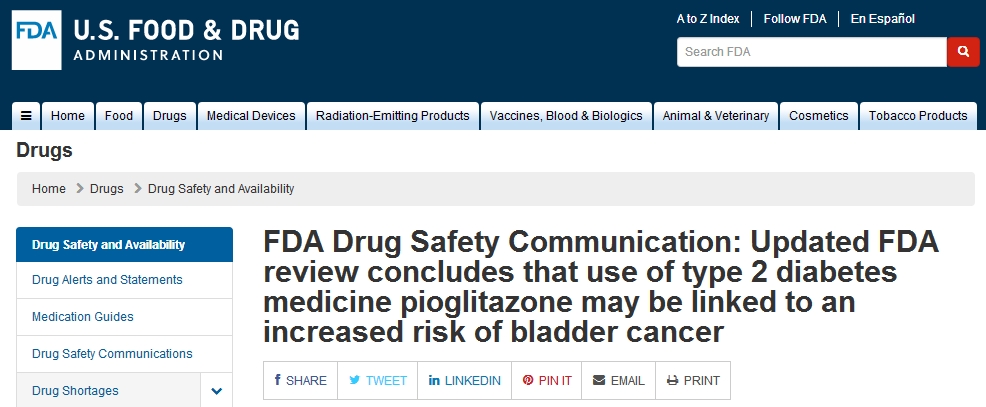Search Product
Structure Search
Search
Advantage Products
Location: Industrial Info
FDA Approved Label Updates for Hypoglycemic Agents Pioglitazone
2016-12-15
来源:转载自第三方
15 December 2016
12 December 2016, FDA issued that the use of the type II diabetes medicine pioglitazone may be linked to an increased risk of bladder cancer. The labels of pioglitazone-containing medicines already contain warnings about this risk, and FDA have approved label updates to describe the additional studies.

Diabetes is a kind of metabolic diseases characterized by hyperglycemia due to insulin secretion or defects of function. In diabetic patients, 90%~95% of patients are type II diabetes. The pathogenesis of type II diabetes is only partly known, but also includes varying degrees of islet β-cell function decreased, the surrounding tissue insulin resistance and abnormal glucagon metabolism. At present, there are many type of non-insulin diabetes drug on the market, showing a highly competitive structure. According to different mechanisms, they can be divided into the following types, see Table 1,
Table 1. Mechanisms and representative drugs of non-insulin diabetes drug
Types | Mechanisms | Representative drugs |
|---|---|---|
Sulfonylurea insulin secretagogue | Act on the sulfonylurea receptor of β-cell membrane, promote the release of insulin | Gliclazide, glipizide, glimepiride, etc. |
Non-sulfonylurea insulin secretagogue | meglitinide repaglinide, phenylalanine derivatives nateglinide. | |
Biguanides | Promote sugar anaerobic glycolysis, increase the glucose uptake and utilization in peripheral tissue, protect islet β cell | metformin |
α-glucosidase inhibitor | Reversibly inhibits α-glucosidase activity in the intestinal mucosa, reduces the digestion of complex polysaccharides and sucrose, delays uptake of glucose | acarbose, voglibose |
Thiazolidinediones | increase the sensitivity of target tissue to insulin, reduce insulin resistance | pioglitazone, rosiglitazone |
GLP-1 receptor agonist | stimulates islet β cells to secrete insulin and inhibits glucagon secretion, lowers blood glucose levels | Exenatide, Apripro Peptide, etc. |
DPP-IV inhibitors | extend activity of GLP-1 and GIP, promote insulin secretion, reduce glucagon secretion, control blood glucose | vildagliptin (intermediate 3-amino-1-adamantanol), Alogliptin, etc. |
SGLT-2 inhibitors | excrete excess glucose from the urine, reduce glycosylated protein, improve insulin sensitivity in liver and peripheral tissues, improve β-cell function improve hepatic insulin resistance | O-aryl inhibitors, C-aryl An inhibitor, a S-glycoside inhibitor, and an N-glycoside inhibi |
Pioglitazone does not stimulate the secretion of insulin, but give play of hypoglycemic effect by enhancing the organization's sensitivity to insulin. These drugs apply to type II diabetes, impaired glucose tolerance and metabolic syndrome, they can be used with biguanides, sulfonylurea drugs or insulin in combination to further improve blood glucose control, and will not cause hypoglycemia when used alone. It is considered as an ideal drug for the treatment of diabetes .
FDA requires drug manufacturers to continue their 10-year epidemiological studies and to modify the efficacy of pioglitazone-containing drugs in the formulation of the drug label, which already contains warnings about increasing the risk of bladder cancer. Recently, FDA reviewed additional studies evaluating the risk of pioglitazone treatment in patients with bladder cancer. The results varied among the reviewed studies, for example: the 10-year epidemiologic study 1 did not find an increased risk of bladder cancer with pioglitazone use, whereas another study did; In addition, a randomized controlled trial found an increased risk during the trial period; however the risk did not persist when patients were followed after the trial was completed. In 2010, bladder tumors were seen with pioglitazone exposure in animal studies.
Overall, the data indicate that pioglitazone may be associated with an increased risk of bladder cancer. A few days ago, according to the results of the review, FDA has approved manufacturers to further modify drug labeling based on the latest research information.
Patients with history of bladder cancer should be carefully considered before use of pioglitazone. Patients should contact doctors if you experience any of the following signs or symptoms after starting pioglitazone, as these may be due to bladder cancer: Blood or a red color in the urine, new or worsening urge to urinate, pain when urinating. In addition, when choose the drugs, patients should be based on the severity of the disease, drug side effects, patient tolerance and treatment guidelines and avoid blind medication.
Related Link: 3-amino-1-adamantanol
Edited by the Editorial Office of Suzhou Yacoo Science Co., Ltd.
如果涉及转载授权,请联系我们。












